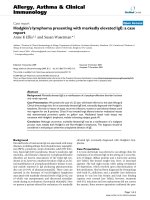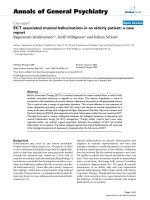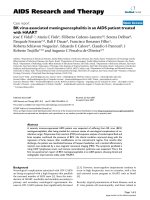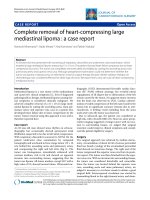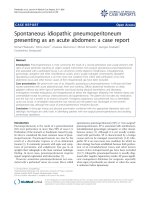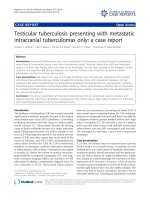Báo cáo y học: "Unusual Epstein-Barr esophageal infection in an immunocompetent patient: a case report" ppsx
Bạn đang xem bản rút gọn của tài liệu. Xem và tải ngay bản đầy đủ của tài liệu tại đây (170.5 KB, 3 trang )
Case report
Open Access
Unusual Epstein-Barr esophageal infection in an immunocompetent
patient: a case report
Magdalini Pape
1
*, Kalliopi Mandraveli
1
, Ioannis Sidiropoulos
2
,
Dimitrios Koliouskas
2
, Stella Alexiou-Daniel
1
and Filanthi Frantzidou
1
Addresses:
1
Department of Microbiology, School of Medicine, Laboratory of Infectious Diseases, AHEPA University Hospital of Thessaloniki,
Greece and
2
First Propedeutic Medical Department, AHEPA University Hospital, Aristotle University of Thessaloniki, Greece
Email: MP* - ; KM - ; IS - ; DK - ; SA-D - ;
FF -
* Corresponding author
Received: 5 December 2007 Accepted: 22 January 2009 Published: 29 June 2009
Journal of Medical Case Reports 2009, 3:7314 doi: 10.4076/1752-1947-3-7314
This article is available from: />© 2009 Pape et al; licensee Cases Network Ltd.
This is an Open Access article distributed under the terms of the Creative Commons Attribution License (
/>which permits unrestricted use, distribution, and reproduction in any medium, provided the original work is properly cited.
Abstract
Introduction: Epstein-Barr virus esophagitis in an immunocompetent host is a rare entity. It
represents either primary infection or reactivation and is usually characterized by acute onset and
extensive ulcerative involvement of the upper and middle third of the esophagus.
Case presentation: A case of Epstein-Barr virus esophagitis in a 27-year-old woman with no
immunosuppressive factors, and having gastrointestinal symptoms is reported here. Using real-time
polymerase chain reaction, biopsy and blood specimens were tested for candida and herpes viruses.
Epstein-Barr virus DNA was detected in tissue samples. The patient was treated with acyclovir with
resolution of the symptomatology.
Conclusions: The prevalence of esophagitis remains undefined in both immunodeficient and
immunocompetent individuals and should be taken into consideration in a patient presenting with
esophageal symptoms. This case report stresses the role of Epstein-Barr virus infection in the
pathogenesis of esophagitis, a rare condition in an immunocompetent host. In this setting, active
infection may represent a primary infection or reactivation. Histopathological examination alone may
miss the diagnosis, while polymerase chain reaction techniques optimize the diagnostic sensitivity,
establish a diagnosis, and lead to an appropriate therapy.
Introduction
Esophageal infections are a well known complication and a
significant cause of morbidity in patients with an impaired
immune system [1,2]. Patients at high risk are com-
monly HIV-infected and leukopenic individuals, recipients
of transplants or recipients of immunosuppr essive
medications [3,4]. The most frequently identified esopha-
geal pathogens are candida [1], cytomegalovirus (CMV) [5],
and herpes simplex virus (HSV) [6]. Epstein-Barr virus
(EBV) is an important human pathogen, causing a variety
of syndromes. Infections of the gastrointestinal tract, a
common form of disease of EBV, are usually manifest as
Page 1 of 3
(page number not for citation purposes)
colitis and Crohn’s disease [7,8]. However, the prevalence of
EBV esophagitis remains undefined in both immunodefi-
cient and immunocompetent individuals and should be
taken into consideration in a patient presenting with
esophageal symptoms.
Case presentation
A 27-year-old woman with no past medical history was
admitted to the emergency department of our hospital
with a 7-day history of dysphagia, especially for solid food,
and odynophagia. She had no previous history of upper
gastrointestinal complaints or any systemic symptoms.
Her physical examination was normal as was an abdom-
inal computed tomography (CT) scan. Routine admission
laboratory studies were normal and serological tests
(ELISA AXSYM Abbott) for anti-cytomegalovirus, anti-
Epstein–Barr virus, anti-herpes simplex virus and anti-
varicella zoster virus IgG/IgM antibodies excluded primary
infection or reactivation. The serology results for EBV were:
IgG (+) 125 IU/ml, IgM (-).
The patient underwent esophagoscopy, using an Olympus
endoscope and multiple, well circumscribed ulcerations
were identified in the upper and middle section of the
esophagus. The ulcers were characterized as either shallow
or of intermediate depth. A few deep ulcers were also seen.
Viral infection was taken into consideration on the basis of
the gastrointestinal symptoms and in the absence of any
other demonstrable causes such as drug-induced esopha-
gitis. Biopsy specimens were obtained from the identified
ulcers and submitted for histopathologic evaluation.
Tissue sections were also stained with hematoxylin and
eosin. Microscopically, all specimens showed non-specific
features of active esophagitis, including ulceration, neu-
trophilic and eosinophilic inflammation, and a basal cell
hyperplasia. No viral inclusions, hyperchromaticity, or
atypical mitoses were observed. Using real-time polymer-
ase chain reaction (PCR) (artus LC PCR, QIAGEN), biopsy
and blood specimens were tested for the most and less
frequently identified esophageal pathogens (candida,
CMV, HSV, EBV). No candida, CMV, HSV or EBV DNA
was detected in blood samples. EBV DNA was detected
only in tissue samples (1.6 ¥ 10
3
copies/ml). Therefore, the
patient was started on treatment with acyclovir at an oral
dosage of 800 mg, five times daily for 5 days, with good
resolution of the symptomatology. Follow-up endoscopic
examination showed a clear improvement. PCR on biopsy
materials was once more performed, but no EBV genome
could be detected. Blood samples were also obtained, but
no serological evidence of infection was reported. The
patient has subsequently remained symptom-free.
Discussion
Herpes virus esophagitis is a well-known infectious
complication in patients with impaired immune system,
and has also been described as a self-limiting illness in
immunocompetent patients. The herpes viruses so far
related to esophagitis are CMV and HSV. Although a few
reports have suggested the role of EBV in esophagitis, we
believe that EBV infection may activate immune-mediated
mechanisms eventually leading to tissue damage. This case
report stresses the role of EBV infection in the pathogenesis
of esophagitis, a rare condition in the immunocompetent
host. In this setting, active infection may represent a
primary infection or reactivation.
Histopathological examination alone may lead to incor-
rect diagnosis, while PCR techniques optimize the
diagnostic sensitivity, establish a firm diagnosis and lead
to an appropriate therapy.
Conclusions
EBV infection should be considered in all symptomatic
patients, immunocompetent or not, in whom esophageal
ulceration is identified endoscopically and who are not
being treated with immunosuppressants and/or corticos-
teroids. The PCR technique clearly establishes the diag-
nosis, leading to an appropriate treatment.
Consent
Written informed consent was obtained from the patient
for publication of this case report. A copy of the written
consent is available for review by the Editor-in-Chief of
this journal.
Competing interests
The authors declare that they have no competing interests.
Authors’ contributions
PM is the primary contributing author. SI is a pathological
specialist and was the medical internist responsible for
the patient. All authors read and approved the final
manuscript.
Acknowledgements
There is no funding source since this brief case report had
no cost. Mandraveli Kalliopi, the Associate Director of the
Infectious Disease Department of AHEPA Hospital, Stella
Alexiou-Daniel, Professor of Medical Microbiology and
Koliouskas Dimitrios, Associate Director of the First
Propedeutic Medical Department are all thanked for
their help in reading the final manuscript.
References
1. Baehr PH, McDonald GB: Esophageal infections: risk factors,
presentation, diagnosis, and treatment. Gastroenterology 1994,
106:509-532.
2. Conolly GM, Hawkins D, Harcourt-Webster JN, Parsons PA,
Husain OA, Gazzard BG: Esophageal symptoms, their causes,
treatment, and prognosis in patients with the acquired
immunodeficiency syndrome. Gut 1989, 30:1033-1039.
Page 2 of 3
(page number not for citation purposes)
Journal of Medical Case Reports 2009, 3:7314 />3. Claudio PO, Patrizia PA: Gastrointestinal complications in renal
transplant recipients. Transplant Int 2005, 18:643-650.
4. Wilcox CM, David A, Schwartz W, Scott C: Esophageal ulceration
in human immunodeficiency virus infection: causes, response
to therapy, and long-term outcome. Ann Intern Med 1995,
123:143-149.
5. Bodak DA: Gastrointestinal infections caused by Cytomegalo-
virus. Curr Infect Dis Rep 2003, 5:101-107.
6. Ramanathan J, Rammouni M, Baran J Jr, Khatib R: Herpes simplex
virus esophagitis in the immunocompetent host: an over-
view. Am J Gastroenterol 2000, 95:2171-2176.
7. Bertalot G, Villanci V, Gramegna M, Orvieto E, Negrini R, Saleri A,
Terraroli C, Ravelli P, Cestari R, Viale G: Evidence of Epstein-Barr
virus infection in ulcerative colitis. Dig Liver Dis 2001, 33:551-558.
8. Wakefield AJ, Fox JD, Sawyerr AM, Taylor JE, Sweenie CH, Smith M,
Emery VC, Hudson M, Tedder RS, Pounder RE: Detection of
herpesvirus DNA in the large intestine of patients with
ulcerative colitis and Crohn’s disease using the nested
polymerase chain reaction. J Med Virol 1992, 38:183-190.
Page 3 of 3
(page number not for citation purposes)
Journal of Medical Case Reports 2009, 3:7314 />Do you have a case to share?
Submit your case report today
• Rapid peer review
• Fast publication
• PubMed indexing
• Inclusion in Cases Database
Any patient, any case, can teach us
something
www.casesnetwork.com
